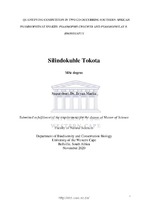| dc.contributor.advisor | Maritz, Bryan | |
| dc.contributor.author | Tokota, Silindokuhle | |
| dc.date.accessioned | 2021-05-31T07:56:31Z | |
| dc.date.available | 2021-05-31T07:56:31Z | |
| dc.date.issued | 2020 | |
| dc.identifier.uri | http://hdl.handle.net/11394/8265 | |
| dc.description | Magister Scientiae (Biodiversity and Conservation Biology) - MSc (Biodiv and Cons Biol) | en_US |
| dc.description.abstract | Studies on snake competitive interactions have relatively been well documented globally, however, those examples tend to be dominated by non-African examples. Africa has a large and spectacular reptile diversity and yet robust and empirical studies on snake population ecology remain poorly understood or documented. Given the close phylogenetic relationship between the two species, as well as the remarkable similarities in overall appearance, morphology, reproductive biology, and most importantly geographic distribution, Psammophis crucifer and Psammophylax rhombeatus offered an ideal study system in which to ask questions related to interspecific competition and niche partitioning. | en_US |
| dc.language.iso | en | en_US |
| dc.publisher | University of Western Cape | en_US |
| dc.subject | Competition | en_US |
| dc.subject | Niche partitioning | en_US |
| dc.subject | Psammophylax r. rhombeatus | en_US |
| dc.subject | Psammophis crucifer | en_US |
| dc.subject | Diet | en_US |
| dc.title | Quantifying competition in two co-occurring southern African psammophiinae snakes: Psammophis crucifer and psammophylax r. Rhombeatus | en_US |
| dc.rights.holder | University of Western Cape | en_US |

